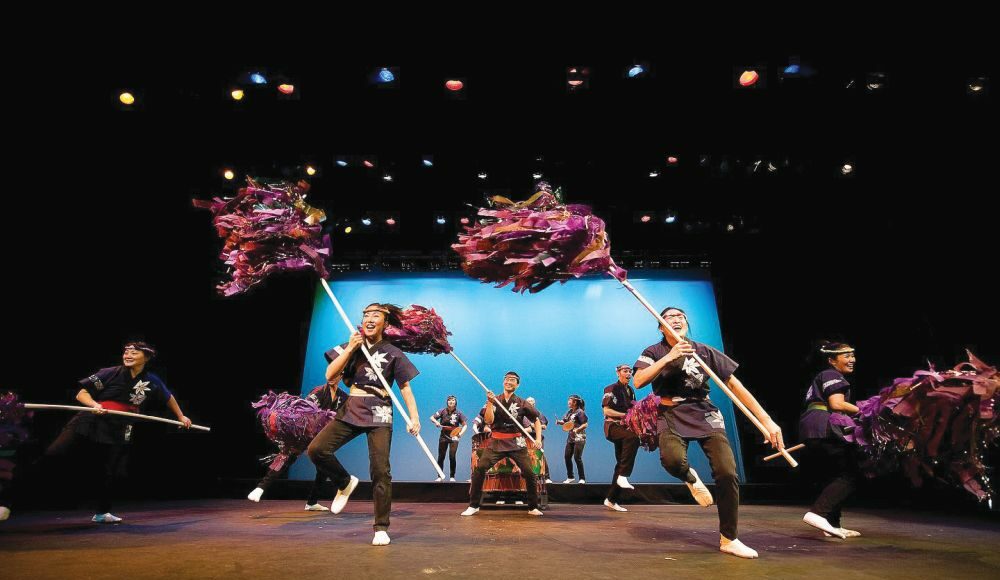Though the roots of San Jose’s Japantown neighborhood date back to the early 1900s, San Jose Taiko has established itself over the last half-century as the community’s modern-day heartbeat.
The musical conservatory and educational organization celebrates a monumental anniversary on Oct. 14 with a concert program two years in the making. The San Jose Taiko 50th Anniversary Concert at the California Theater will run an evening show and a matinee.
Executive Director Wisa Uemura and Creative Director Franco Imperial both auditioned in 1998, joining San Jose Taiko halfway between the ensemble’s beginning and present day. Uemura began playing in a taiko ensemble while studying at Stanford, and Imperial had marked each stage of his life thus far with a different percussive form: high school marching band, rocking out with friends in college, and later kulintang, a style of gong-and-drum ensemble indigenous to parts of the Philippines and Southeast Asia.
“…and then I stumbled on taiko,” says Imperial. Uemura smiles as he continues “it just sort of grabs you and doesn’t let go.”
Beyond using one’s hands and wrists to play, taiko drumming is a full-body practice. SJT expresses this in their philosophy of four key principles: attitude, kata (which encompasses physicality, choreography and stance), musical technique and ki (analogous to the Chinese concept of life force written in English as chi or qi).
The first half of the concert is a mega-medley of compositions from throughout the company’s history, as Uemura explains, has become tradition for San Jose Taiko milestones.
While versions of what we know as the taiko drum have been played for millennia, featured at festivals and shrines as well as on the battlefield, ensemble-style taiko performance was developed over the last century.
San Jose Taiko’s founding came a mere 14 years after Oedo Sukeroku Taiko, recognized as the first professionally touring taiko ensemble, formed in Japan. As such, San Jose Taiko’s early repertoire consisted almost entirely of original compositions by company members. Uemura and Imperial describe the experience of reaching out to some of these composers in preparation for the concert.
“Some of the songs [in the medley] are what young people would call ‘deep cuts,’” Uemura explains with a laugh. “There was a lot of learning: revisiting video, notations that we have in our archives, and talking to members or composers that had been in the company then[…]to get the nuance of the musicality that can’t be notated.” A few San Jose Taiko alumni will make guest features at the concert but specifics are still under wraps.
“What nobody but a taiko person will appreciate,” Imperial says with a laugh, “is the choreography of equipment movement, and the seamlessness of transitions between songs.”
Act two of the program is a block of songs representing Japantown’s community history, including debuts of four new compositions. A painful yet crucial part of this history is the forced relocation and incarceration of Japanese-Americans during World War II, which San Jose Taiko remains dedicated to educating the public about through their programming and relationships with organizations such as Heart Mountain Interpretive Center in Wyoming, which stands on a former confinement site.
“Some of it is on the dark side, but important as ambassadors of Japantown to really represent,” says Imperial.
While honoring the past, San Jose Taiko also celebrates future generations of Japantown. The company is currently developing a concert program for children: “…very much inspired by our work with organizations in Japantown like Lotus Preschool, and [summer program] Suzumen o Gakko,” Imperial continues.
The narratives are aided at times by poetry, spoken word and a sprinkle of theatre inspired by kamishibai, a form of illustrated, performed storytelling with origins in Depression-era Japan. “Overall,” however, Uemura clarifies: “we let the taiko tell its own story.”
The larger-than-life sound of taiko drumming lends its power to all kinds of stories. With a feature in Cartoon Network’s upcoming Craig of the Creek movie soundtrack (scored by punk icon Jeff Rosenstock), the group leaves their mark on pop culture as well.
San Jose Taiko is many things––performance ensemble, educational resource, community space. Beyond the sum of its parts, it’s also an ongoing storytelling project committed to its history while always expanding into new chapters.
San Jose Taiko’s Anniversary Concert: 50 and Beyond
Oct. 14, 2pm & 7:30pm
California Theatre



